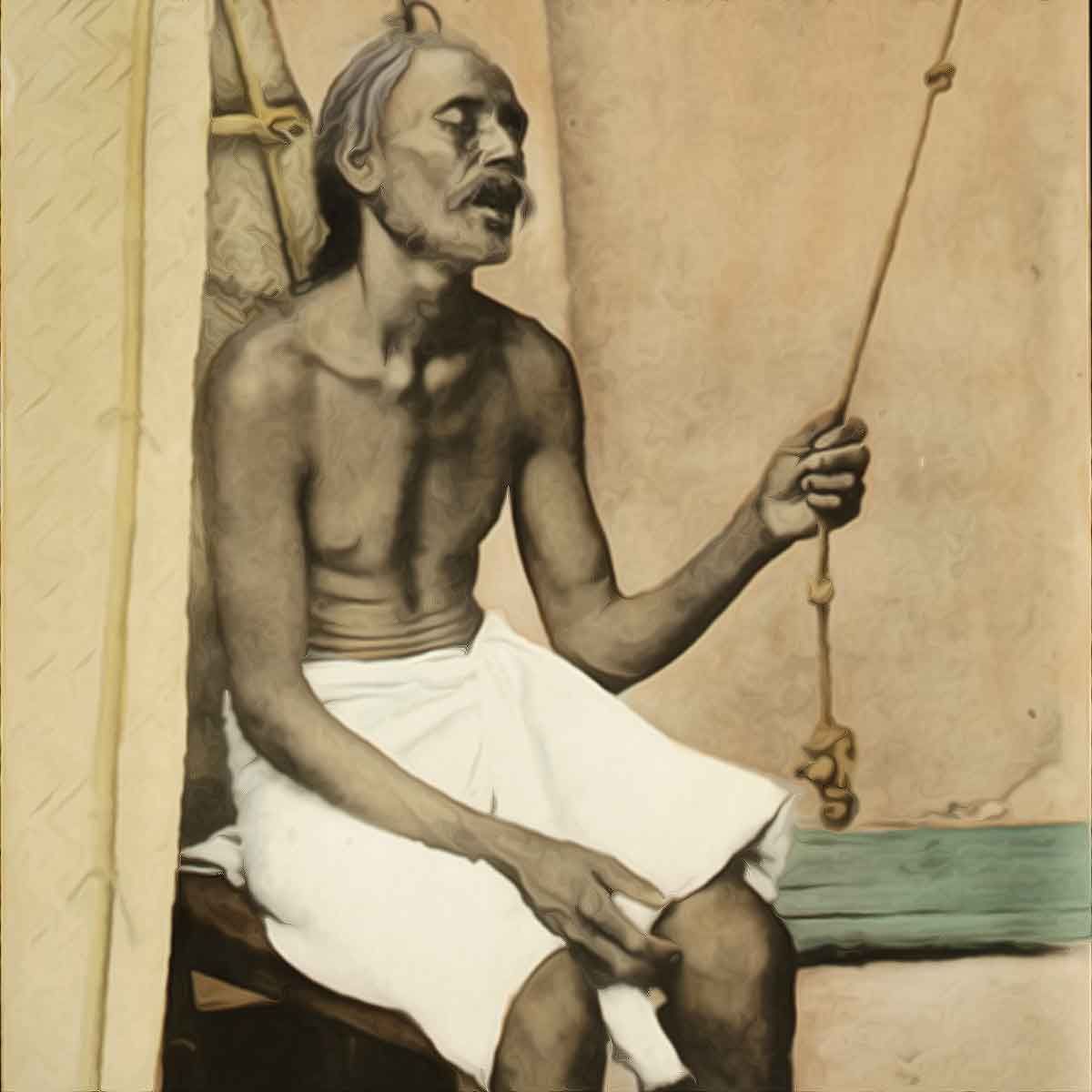Sanatan Articles
Satyaagrah
Written on
Satyaagrah
Written on
Satyaagrah
Written on
Satyaagrah
Written on
Satyaagrah
Written on
JOIN SATYAAGRAH SOCIAL MEDIA
"All violence, all that is dreary and repels, is not power, but the absence of power": Punkah - the hand operated ceiling fans of Colonial India and a reminder of how British colonials exploited ‘punkah-walas’ in India’s summers extracting constant labor

Sleep is a luxury for those who struggle to get a good night’s rest. While the inability to sleep well can be frustrating in the middle of the night, the necessity for sleep in pre-electricity days produced its own violence in colonial India.
|
When the British first came to India, they had to adapt themselves to a lot of unfamiliar things, such as the climate, the blood-sucking mosquitos, the spicy food, and the language. But the one thing they couldn’t get used to was the heat.
Summer in India begins in April and lasts until October. In the north and the west, the summer arrives early. In this part of India, April and May are usually the hottest months after which the monsoon helps keep temperatures down. In eastern India and in the coastal regions, rains delay the onset of summer. But as rainfall becomes scarce, the heat begins to build up, which is exacerbated by the humidity from the sea creating a very suffocating experience.
Before the arrival of electricity, it was not uncommon for people to sleep outside their homes under the shade of a tree, where it was cooler, or in the verandah with a handheld fan. Those who could afford had punkahs, or ceiling fans, that were swung with the help of a long string to produce a cooling draft.
A punkah was usually rectangular in shape and was made from cane, or a flat wooden frame covered with cloth. It was suspended from the ceiling of a room and pulled by the means of a rope and pulley by servants or slaves called punkah-wallah. The rhythmic to-and-fro movement of the punkah generated a gentle breeze that allowed the British expats and wealthy Indians to work and sleep in comfort.
Punkahs were a luxury found only in palatial homes and government bungalows and offices. As one British resident described, “you have a punkah over your bed, another over your bath-tub, another at your dressing-bureau, another over your dining-table, and another above your desk. Your body servant calls out to your punkah-wallah and has him shift from one cord to another as you move about your room, or go from one room to another. You have the punkah in motion all day and all night somewhere, and for this purpose you must have two men to relieve each other. When you go to bed … you are fanned to sleep.”
|
The punkah – a swinging cloth fan on a frame – was a summer device in use before the British had come to India, as Ritam Sengupta’s innovative research suggests. But it became the most intriguing “labour-intensive” piece of crude fan technology during colonial rule.
It also needed Indian servants who would pull the rope of a punkah throughout the night and day with breaks in the early morning and in the evening. Installed in courtrooms, cantonments, offices, schools, European and elite Indian households, punkahs and their pullers helped colonialism function at a pace that would have not been possible had the rulers suffered from a long sleep deficit.
Sengupta’s research has covered some of these arenas from the angle of domestic labour, colonial exploitation, and the harsh treatment of servants. My focus here is on the bedrooms of the White people and their sleep to chart out how human structures of sleep could create a regime of cruel, racial violence.
The punkah-wallah sat in the corner of the room and pulled the rope keeping the fan in motion. Because he was always within earshot, many employers preferred punkah-wallahs who were deaf so that they could discuss private and confidential matters without getting eavesdropped. Sometimes, the rope would pass through a small hole in the wall near the ceiling so that the punkah-wallah could sit on the other side of the wall outside the room, or even outside the house.
The job of a punkah-wallah was not hard, but it was definitely tedious. In The Complete Indian Housekeeper and Cook, authors Steel and Gardiner suggest that punkah-wallahs were quite lazy:
In regard to punkah, in the writer's opinion they are comparatively of little use except to keep away mosquitoes, or when sleeping on the roof. At mealtimes they are a necessity. But they are too intermittent a palliative to be satisfactory. The presence of a punkah rope in a coolie's hand seems positively to have a soporific effect on him ...
Punkah coolies always came from the poorest groups in society. They received a paltry sum for their services, yet they were indispensable in the tropical climate of India.
Punkahs eventually started appearing in many places beyond the Indian subcontinent. They became a notable fixture in the homes of many plantation owners in the southern states of America, where there was certainly no shortage of punkah-pullers.
|
The fan-pullers were cheap “native” labourers who stayed awake through the night as their masters took a refreshing sleep. She wrote, “Under the punka we write, read, eat, sleep, study or sew”.
Research suggests that colonial officials, whether Indian or British, slept between 9 and 10 pm in the summer. The White officials usually delayed their sleep to write letters to their family members in Britain or do paperwork. Here is one TS Abott writing about this struggle:
“The punka wallah plagues one almost to death. You have two sets of these men, one set for day, and one for night. Yet they are such cheats that your night men will let themselves out by the day, and then come to you at night half dead for want of sleep. They pull your punka till you fall asleep, then stop, lie down, and go to sleep themselves. By and by you awake with a start, and are wet through with perspiration, and lo! the punka hangs listlessly above one’s head. Then one gives it a pull, and sometimes it starts the fellow up, and he pulls till you are just dozing off, and then stops. By this time one’s temper gets started, and out of bed, he flies, and out he goes and find the punka man stretched out on the cool marble pavement asleep and snoring. Well, you give him a good kick, or resounding slap on the side of his head, at the same time calling him a sewer [suar ka baccha].”
Irritated Abott also threw jars of water, which his bearer usually kept next to his bed for drinking and punishing a truant servant, on the punkah-walas. Others broke earthen pots filled with water on their sleepy servants. The punkahs and punkah-walas were intrinsically webbed into the sleep economy of colonialism, allowing colonial rulers to manage the Indian summer.
The air produced from the force of the punkah varied and was called different names: the side on which the puller sat was called the Bombay side and the other was called the Bengal side. This terminology emerged from the fact that the south-western monsoon, when it hits Bombay, is at its peak and then slows by the time it reaches West Bengal.
A pair of punkah-walas would usually manage the string for twelve hours at a stretch and were then replaced by the other team. In the humid months of August and early September when flies and mosquitoes were in abundance the punkah was needed the most. The wealthy White families had punkahs over the bed, bathtub, dining table and in areas where they sat for long.
Colonialists had created an edifice of physical torture to extract constant labour from fan-pullers. Middle-class families, like Johnson’s, despite being missionaries, used violent methods. Possibly referring to the tying of the hairs of servants with a rope so that they do not fall asleep, Rachel wrote, “The old fellow with the little top knot, who pretends to keep us cool, has to sleep carefully, so as not to stop pulling; or ‘top knot’ might have troublesome dreams.”
|
It were the tea and indigo planters in far-off secluded regions, known for their violent labour extraction, who created particular types of punishments for their punkah-walas.
One of the methods was to sprinkle sugar on the ground where the punkah-pullers sat and when they fell asleep, their ants would be able to bite their sweaty bodies. The other method was to keep a live duck or goose under the arms of pukah-pullers and those who let the bird while on duty were punished.
The Indian summer was popularly called the punkah season, and the British passionately waited for it to be over. Henry M Layman, an American doctor writing on sleep disorders in the late 19th century, observed the sleeping problems of the colonial officials. In his 1885 book titled Insomnia and Other Disorders of Sleep, Layman wrote that the Indian summer with humidity was a proper cause of insomnia.
The advent of electricity and the development of the electric ceiling fan in the late 19th century signaled the end of the road for those involved in the profession.
References:
 Support Us
Support Us
Satyagraha was born from the heart of our land, with an undying aim to unveil the true essence of Bharat. It seeks to illuminate the hidden tales of our valiant freedom fighters and the rich chronicles that haven't yet sung their complete melody in the mainstream.
While platforms like NDTV and 'The Wire' effortlessly garner funds under the banner of safeguarding democracy, we at Satyagraha walk a different path. Our strength and resonance come from you. In this journey to weave a stronger Bharat, every little contribution amplifies our voice. Let's come together, contribute as you can, and champion the true spirit of our nation.
 |  |  |
| ICICI Bank of Satyaagrah | Razorpay Bank of Satyaagrah | PayPal Bank of Satyaagrah - For International Payments |
If all above doesn't work, then try the LINK below:
Please share the article on other platforms
DISCLAIMER: The author is solely responsible for the views expressed in this article. The author carries the responsibility for citing and/or licensing of images utilized within the text. The website also frequently uses non-commercial images for representational purposes only in line with the article. We are not responsible for the authenticity of such images. If some images have a copyright issue, we request the person/entity to contact us at satyaagrahindia@gmail.com and we will take the necessary actions to resolve the issue.
Related Articles
- Winning wars but losing the peace: Sri Krishna and Mahatma
- Queen Victoria to her Viceroy, “Though the Muhammadans’ cow-killing is made the pretext for the agitation, it is in fact, directed against us, who kill far more cows for our army, than the Muhammadans"
- Northeast is not the Part of Pakistan because of 'Netaji': Subhas Bose and the ‘special’ case of Assam
- At school Part I - An Indian Pilgrim (Netaji's Life and writings)
- 16 year old freedom fighter Shivdevi Tomar, who killed 17 Britishers and wounded many
- A revolutionist freedom fighter who the British Raj framed for murder
- Gandhi emphasized that he won't salute Indian National Flag if Charkha is replaced by Ashoka Chakra and wanted British flag added to it
- A Great man Beyond Criticism - Martyrdom of Shaheed Bhagat Singh (Some Hidden Facts)
- The perpetrator of the Jallianwala Bagh massacre General Reginald Dyer was forgiven by Mohandas Gandhi as an exercise of forgiveness or love to nurse Dyer back to life if he was suffering from a physical malady
- The Residue of Christianism - Hindu Society Under Siege
- Maligning of India by British Raj since the 1800s
- “The blunders are all there on the board, waiting to be made”: Chess was born out of the India before 600s AD from 'Chaturanga' as a battle formation mentioned in Mahabharata, referring to 4 divisions of an army - elephantry, chariotry, cavalry & infantry
- Theft on a Grand Scale - Britain stole $45 Trillion from India and lied about it. Indian money developed Britain and Other Countries
- King Uthram Thirunal Marthanda Varma of Travancore presented Ivory Throne and a stool as a gift objects to Queen Victoria, become an integral part of Queen's interiors
- "भूले तो नहीं": In 1860, the ship Truro & Belvedere brought 680 Indian indentured laborers to South Africa, beginning a journey of hardship that has since evolved into a thriving Indian community deeply embedded in South Africa's culture and history today





















